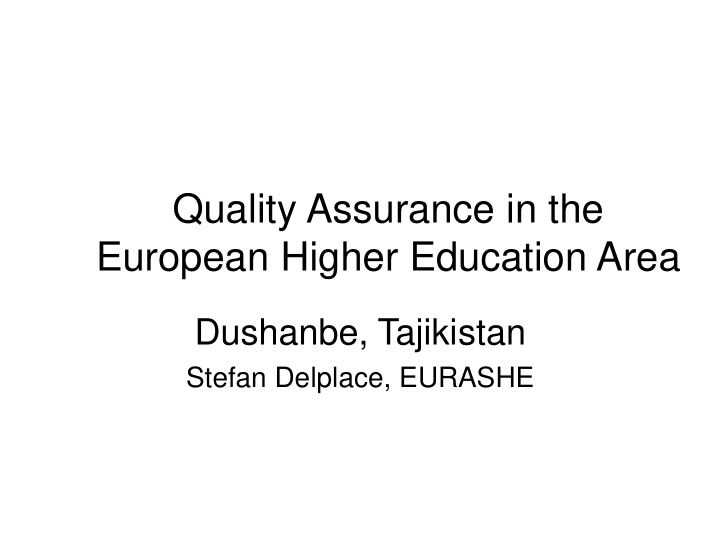



Quality Assurance in the European Higher Education Area Dushanbe, Tajikistan Stefan Delplace, EURASHE
Early beginnings of QA in HE • Modern quality management came from the industrial sector • Non-profit sector and public sector were slow in following • The introduction resulted from external pressures: massification of HE, economic crisis, less gvt funding, HEIs more autnonomous and more accountable, globalisation & liberalisation of education sector
Then came ‘Bologna’ • BP Introduced quality management systems: “Promotion of European co -operation in QA, with a view to developing comparable criteria and methodologies” (Bologna Declaration) • Related to the own objectives of Bologna: - 2-cycle degree structure; stimulation of mobility; demands of labour market and of graduates
Then came ‘Bologna’ • Conditions for ‘Bologna’ had to be fulfilled first, but even then differences remain: – Transparency, compatibility and comparability of degrees (system and diplomas) – A voluntary process involving 46 countries, joining at (in) different moments (stages) – Differentiation has an impact on QA systems, objectives, methodology, etc. – Also reflected in the external evaluation systems
Evolution/stages in QA in the Bologna Process • From the start: no uniform imposed system: but harmonisation of existing systems based on trust • Quality control to secure mentioned objectives of (conditions for) Bologna • Need felt for mutually shared QA criteria, methodologies on institutional, national and European levels. • Four ‘E’s” (ENQA, EUA, EURASHE, ESU) to develop QA standards and planned a Q label for QA agencies, the EQAR (Register of agencies)
Growing Focus on QA in the Bologna Process • next to European Standards and Guidelines for QA, ‘Bologna ministers’ adopted the overarching framework for qualifications in the EHEA (built on three cycles: BA/MA/phD) • ‘mutual recognition’ became a cornerstone in the process (of accreditation & of QA decisions)
European Standards & Guidelines * They are ‘generic’ S & G, allowing for diversity in the EHEA * They cover three areas: – QA in institutions/universities – QA of the external evaluation – QA of the QA agencies * Universal in their application: program /institutional/accreditation/ assessment * External evaluation process with four components: External panel; Self-evaluation; On-site visit, Public review reports
Overarching Qualifications Framework • Originated from so- called ‘Dublin descriptors’ with levels of attainment for each of the three cycles • Bologna countries committed to elaborate national QF aligned to the overarching QF • Complementarity sought between the QF for the EHEA and the European QF (a European Union initiative) encompassing all ‘formal learning’. • A key instrument in the NQF are the ‘learning outcomes’ that are linked to programmes/curriculums
European Register of QA agencies • Set up by the E 4 group in March 2008 to provide the public with clear and reliable information on quality assurance agencies operating in Europe • Listing QA agencies (European and international) that substantially comply with the European Standards and Guidelines for Quality Assurance (ESG) • Involvement of E4, social partners & governments in the “governance” of EQAR • Independent Register Committee decides on acceptance of QA agencies that meet the standards of membership. • Current situation: 18 listed agencies from 9 European countries
Mutual Recognition • Mutual recognition of degrees, etc. a requirement for mobility of students, staff, graduates, and mature learners. • Linked to MR of accreditation or QA decisions, among different (national) agencies. • A system based on thorough knowledge, understanding & ‘trust’ following this. • 2 provisos for mutual recognion of eacht other’s accreditation decisions: acceptance of level of ‘diversity’ and existence of verification procedures (e.g. as organised by ‘ECA’).
Quality Assurance in the EHEA • With thanks to Guy Aelterman, former Vice President of ENQA, (co-) representative of EURASHE in the E 4 group, for QA matters.
Recommend
More recommend